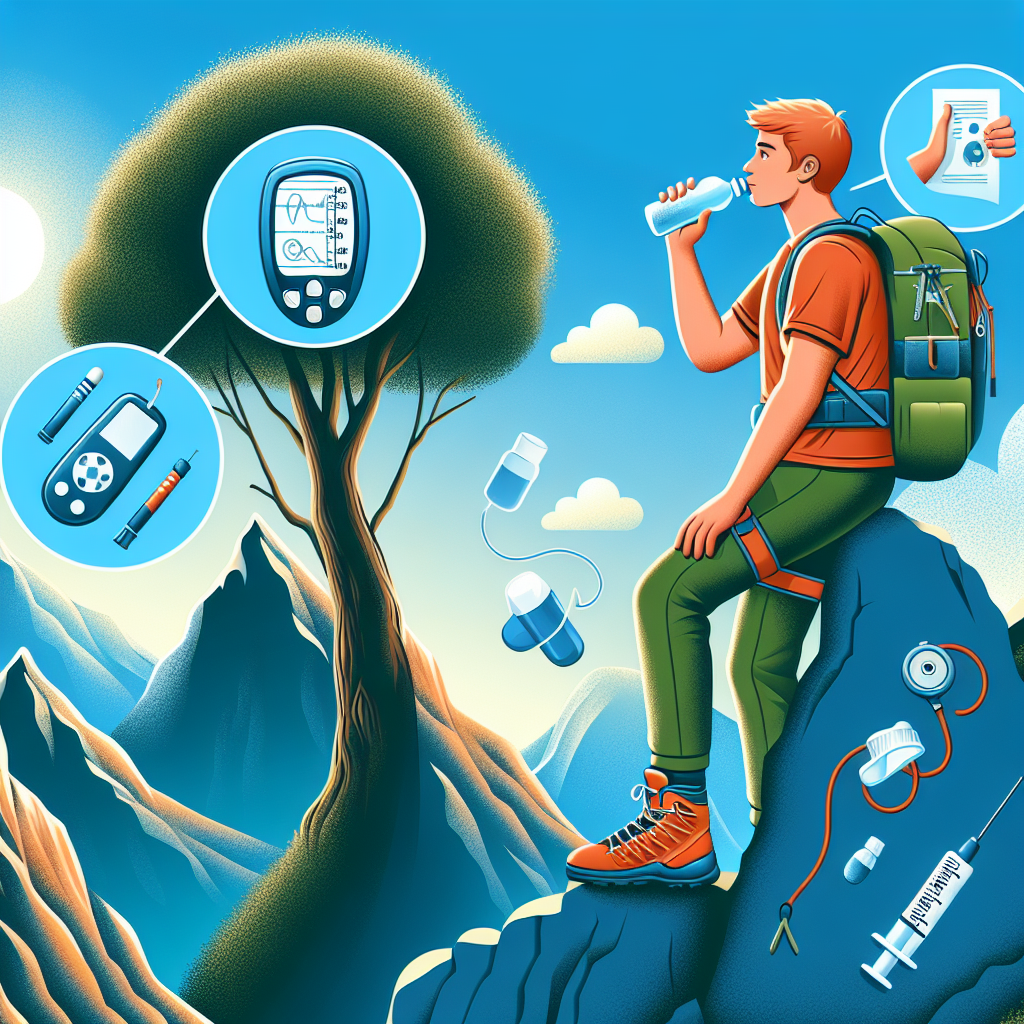Are you a diabetic who loves adventure sports and outdoor activities? If so, this article is for you! Being diabetic doesn’t mean you can’t enjoy thrilling outdoor experiences. With proper preparation and a few adjustments, you can continue to participate in adventure sports and outdoor activities safely and confidently. From hiking and rock climbing to skiing and surfing, we will explore some practical tips and essential precautions to ensure your diabetic condition doesn’t hold you back from the exhilarating world of outdoor adventures. So, lace up your boots, grab your gear, and get ready to embark on unforgettable experiences!
Understanding the Impact of Diabetes
Living with diabetes can present unique challenges, especially when it comes to participating in adventure sports and outdoor activities. It’s important to have a solid understanding of the different types of diabetes and how they can affect physical activities. Diabetes is categorized into two main types: type 1 and type 2.
Understanding type 1 and type 2 diabetes
Type 1 diabetes occurs when the body’s immune system mistakenly attacks the cells in the pancreas that produce insulin. People with type 1 diabetes require regular insulin injections to keep their blood sugar levels in check. On the other hand, type 2 diabetes is characterized by insulin resistance, where the body fails to use insulin effectively. This type of diabetes is often managed through lifestyle changes, such as diet and exercise, and in some cases, medication may be necessary.
How diabetes affects physical activities
Both type 1 and type 2 diabetes can impact physical activities in various ways. Managing blood sugar levels becomes crucial during exercise as the body requires energy to fuel the activity. Without proper management, blood sugar levels can become too high or too low, leading to potential health risks. It is essential to be aware of these potential complications and take the necessary precautions to ensure a safe and enjoyable experience.
Risks involved for diabetics during physical exertion
Engaging in adventure sports and outdoor activities can put an extra strain on the body, especially for individuals with diabetes. It is important to be aware of the potential risks involved to ensure safety during physical exertion. Diabetic individuals may experience a drop in blood sugar levels during intense activities, which can lead to hypoglycemia. Conversely, strenuous activities may cause blood sugar levels to rise, potentially resulting in hyperglycemia. It is crucial to understand how these risks can manifest and take appropriate measures to prevent and address them.
The Importance of Regular Check-Ups
Regular medical check-ups play a vital role in managing diabetes and ensuring overall well-being. These check-ups are essential for diabetics who wish to participate in adventure sports and outdoor activities.
The role of regular medical evaluations
Regular medical evaluations are crucial for monitoring overall health and managing diabetes effectively. These evaluations often involve various tests, such as blood glucose monitoring, blood pressure checks, and cholesterol level assessments. By undergoing these evaluations, you gain a better understanding of your body and can make informed decisions regarding your activities.
Getting a physician’s clearance for sports activities
Before engaging in adventure sports or outdoor activities, it is important to consult with your physician and obtain clearance. Your doctor can assess your current health status and determine if you are physically prepared for the activities you are interested in. They can also provide guidelines and recommendations specific to your diabetes management, ensuring that you can participate in these activities safely.
Routine monitoring of blood sugar levels
Regularly monitoring blood sugar levels is crucial, especially during physical activities. By keeping a close eye on your blood sugar levels, you can make adjustments to your medication, diet, and activities to maintain optimal levels. This monitoring should not be limited to scheduled check-ups but also be done before, during, and after activities to ensure that your blood sugar remains stable.

Customizing Adventure Sport and Outdoor Activities
Participating in adventure sports and outdoor activities as a diabetic requires careful selection and customization of activities to suit your condition. By identifying diabetic-friendly activities and adapting them accordingly, you can enjoy these experiences while managing your health effectively.
Identifying diabetic-friendly activities
Not all activities are suitable for individuals with diabetes, but many options are available that are safe and enjoyable. Some examples of diabetic-friendly activities include hiking, swimming, cycling, and yoga. These activities can be modified based on your fitness level and personal preferences, making it easier for you to engage in physical activities that align with your diabetes management plan.
Adapting activities to support diabetic conditions
It is important to adapt activities to accommodate your diabetes and minimize potential risks. For instance, if you plan to engage in an endurance sport like long-distance running, you may need to alter your training schedule to account for blood sugar management. Regular breaks for blood sugar checks and adjustments, as well as carrying necessary supplies, are important steps in customizing activities to suit your condition.
Knowing your physical limitations
Understanding your physical limitations is key to preventing overexertion and injuries. Diabetes can affect your body’s response to physical activity, and it is important to recognize when you need to take breaks or modify the intensity of your activities. Pushing yourself too hard can lead to adverse health effects, so it is crucial to listen to your body and be mindful of your limitations.
Creating a Diabetes Management Plan
Managing diabetes effectively while engaging in adventure sports and outdoor activities requires a well-thought-out plan. Creating a diabetes management plan can help ensure that you have the tools and strategies in place to navigate potential challenges.
Making a schedule for eating and medication
To effectively manage your diabetes while participating in adventure sports and outdoor activities, creating a schedule for eating and medication is essential. This schedule should account for your activities and blood sugar monitoring. It is important to coordinate meal times and medication administration to ensure that your blood sugar levels are stable before, during, and after activities.
Preparation for fluctuating blood sugar levels
During physical activities, it is common for blood sugar levels to fluctuate. Being prepared for these fluctuations can help you manage your diabetes effectively. Carrying quick-acting carbohydrates, such as glucose tablets or energy gels, can provide an immediate source of sugar to counteract hypoglycemia. Additionally, it is important to communicate your diabetes and any potential needs to others, such as activity partners or event organizers, so they can assist in case of an emergency.
Emergency procedures in case of hypoglycemia or hyperglycemia
Having emergency procedures in place is crucial in the event of hypoglycemia or hyperglycemia. It is important to educate those around you about the signs and symptoms of each condition and how to respond appropriately. Carrying identification that states your diabetes condition and any allergies or medical considerations is also recommended. Additionally, knowing when to seek medical help or contact emergency services is vital to ensure timely intervention in case of severe complications.

Monitoring Blood Sugar Levels During Activities
Monitoring your blood sugar levels during activities is an important aspect of managing diabetes while engaging in adventure sports and outdoor activities. Understanding how different activities affect blood sugar levels and making adjustments based on readings is key to enjoying these activities safely.
Frequency of checking blood sugar during activities
The frequency of checking your blood sugar levels during activities may vary depending on the duration and intensity of the activity, as well as individual needs. It is recommended to check your blood sugar before starting an activity, especially if insulin or medication has been administered recently. Checking every hour during prolonged activities can help you stay on top of any changes and make necessary adjustments to keep your blood sugar levels in a safe range.
Understanding how different activities affect blood sugar
Different activities can have varying effects on blood sugar levels. Strenuous activities that require intense physical effort, such as running or weightlifting, can cause blood sugar levels to drop rapidly. On the other hand, endurance activities like long-distance cycling or hiking may cause blood sugar levels to gradually decrease over time. By understanding how different activities affect your blood sugar levels, you can make informed choices regarding your diabetes management plan and adjust your activities accordingly.
Making adjustments based on readings
Regularly monitoring your blood sugar levels during activities allows you to make adjustments based on your readings. If your levels are trending too high or too low, you can take action by consuming carbohydrates or adjusting your insulin dosage, respectively. It is important to have a plan in place for these adjustments and to communicate them to your activity partners or event organizers, if applicable. Making proactive adjustments based on your blood sugar readings can help prevent complications and ensure that you can continue enjoying your adventures safely.
Proper Nutrition for Diabetic Adventurers
Proper nutrition plays a crucial role in managing diabetes and supporting optimal health during adventure sports and outdoor activities. Following a balanced diet and paying attention to meal times are important factors to consider.
Balanced diet recommendations
A balanced diet is essential for individuals with diabetes, particularly those engaging in adventure sports and outdoor activities. Incorporating a variety of nutrient-dense foods, including whole grains, lean protein, healthy fats, and plenty of fruits and vegetables, can support stable blood sugar levels and provide the energy needed for physical activities. Avoiding sugary or processed foods that can cause blood glucose spikes is also important in maintaining good diabetes management.
Importance of consistent meal times
Consistency in meal times is crucial for diabetics, especially when engaging in physical activities. Regular meals at consistent intervals can help maintain stable blood sugar levels and prevent sudden drops or spikes. Planning your meals ahead of time and ensuring you have access to appropriate food options during activities can help you stay on track with your diabetes management and fuel your body effectively.
Suitable snacks to carry during activities
Carrying suitable snacks during activities is important to prevent hypoglycemia and provide quick energy when needed. Non-perishable snacks that are easy to transport and consume, such as nuts, seeds, dried fruits, or protein bars, can be excellent choices. These snacks should be low in added sugars and provide a good balance of macronutrients to support stable blood sugar levels and sustained energy throughout your activities.

Importance of Hydration
Staying hydrated is a crucial aspect of managing diabetes and supporting overall health during adventure sports and outdoor activities. Proper hydration plays a vital role in regulating body temperature, supporting organ function, and maintaining optimal blood sugar levels.
Understanding the hydration needs of diabetics
Individuals with diabetes may have increased hydration needs due to factors such as frequent urination or the potential risk of high blood sugar levels. It is important to recognize and address these needs to prevent dehydration, especially during physical activities. Being aware of your body’s signals and maintaining a consistent intake of fluids throughout the day can help ensure proper hydration.
Tips for staying hydrated
To stay hydrated while engaging in adventure sports and outdoor activities as a diabetic, consider the following tips:
- Drink water regularly: Make it a habit to drink water before, during, and after your activities.
- Carry a water bottle: Having a water bottle readily available will serve as a reminder to drink and make it convenient to remain hydrated.
- Monitor urine color: Dark-colored urine may indicate dehydration, while lighter-colored urine suggests proper hydration.
- Avoid excessive caffeine or sugary beverages: These can contribute to dehydration and can have a negative impact on blood sugar levels.
- Consider electrolyte-rich fluids: During prolonged activities or in hot environments, electrolyte-rich fluids can help replenish essential minerals lost through sweat.
Signs of dehydration to watch for
Dehydration can have serious consequences, so it is important to be aware of the signs and symptoms. Symptoms of dehydration may include increased thirst, dry mouth, fatigue, dizziness, and decreased urine output. If you experience these symptoms, it is crucial to take a break, rehydrate, and seek shade or cooler environments if necessary.
Proper Foot Care
Foot care is of utmost importance for diabetics, particularly when engaging in adventure sports and outdoor activities. Diabetes can impact foot health, increasing the risk of complications such as foot ulcers or infections.
Reasoning behind increased foot care for diabetics
Diabetes can lead to reduced blood flow and nerve damage, particularly in the feet. These factors can increase the risk of foot problems, as injuries may go unnoticed due to decreased sensation. Proper foot care can help prevent potential complications and ensure the overall health and safety of individuals with diabetes.
Choosing suitable footwear for activities
Selecting suitable footwear for activities is crucial to support foot health and minimize the risk of injuries. Diabetic individuals should opt for well-fitting shoes with supportive soles and adequate cushioning to reduce the risk of blisters, calluses, or foot pain. It is essential to find shoes that provide proper arch support, breathable materials, and sufficient room for the toes to move comfortably.
Checking feet for injuries or sores post-activity
After engaging in adventure sports or outdoor activities, it is important to inspect your feet for any injuries, sores, or signs of discomfort. Diabetic individuals may have decreased sensitivity in their feet, making it necessary to visually inspect for any abnormalities. Treating minor injuries or discomfort promptly can prevent them from developing into more serious complications.

Carrying Necessary Medical Supplies
When participating in adventure sports and outdoor activities, it is crucial to carry essential medical supplies to manage diabetes effectively. Having the necessary supplies readily available can ensure that you are prepared for any situation that may arise.
List of essential diabetic supplies
Diabetic individuals should always carry the following essential supplies:
- Blood glucose monitoring system: A reliable glucose meter, lancets, and test strips to monitor blood sugar levels regularly.
- Insulin and administration supplies: Insulin pens, syringes, or pumps, along with extra vials or cartridges, if needed. It is important to store insulin properly to maintain its efficacy.
- Fast-acting carbohydrates: Quick sources of sugar, such as glucose tablets or gels, to address hypoglycemia episodes promptly.
- Extra medications: If taking medication for diabetes management or other conditions, it is advisable to carry extra doses in case of unexpected delays or emergencies.
- Identification: Carrying identification that states your diabetes condition, any allergies, and emergency contact information is crucial for quick and appropriate medical attention if required.
- Medical alert bracelet or necklace: Wearing a medical alert bracelet or necklace that indicates your diabetes condition can provide valuable information to healthcare professionals in case of emergencies.
Proper storage and handling of insulin during outdoor activities
Proper storage and handling of insulin are essential to ensure its effectiveness and safety during outdoor activities. Insulin should be kept at the appropriate temperature and protected from extreme heat or cold. Insulated cases or pouches specifically designed for insulin storage can help maintain a suitable temperature range. It is also important to monitor insulin expiration dates and rotate supplies regularly.
Emergency supplies to carry at all times
In addition to the essential diabetic supplies, individuals with diabetes should also carry emergency supplies at all times. These may include a first aid kit, emergency contact information, a cell phone for communication, and extra snacks or fluids in case of unexpected delays or emergencies. Being prepared for unforeseen circumstances can make a significant difference in managing diabetes and ensuring your safety during adventure sports and outdoor activities.
Managing Stress and Fatigue
Stress and fatigue can impact blood sugar levels and overall well-being, making it important for diabetics to manage these factors effectively, especially when engaging in adventure sports and outdoor activities.
Recognizing and managing symptoms of diabetic fatigue
Diabetic fatigue is a common symptom that can result from fluctuations in blood sugar levels, physical exertion, or other factors related to diabetes management. It is important to recognize the signs of fatigue, such as persistent tiredness, difficulty concentrating, irritability, or lack of motivation. Managing stress levels, ensuring proper rest and recovery, and maintaining a consistent diabetes management plan can help mitigate these symptoms.
Understanding the influence of stress on blood sugar
Stress can have a significant impact on blood sugar levels, causing them to rise or become more difficult to control. When engaging in adventure sports and outdoor activities, stress levels may increase due to the physical and mental demands of the activities. Being aware of these potential stressors and having strategies in place to manage stress effectively can help maintain stable blood sugar levels and prevent complications.
Balancing activities to avoid over-exertion
Finding a balance between physical activities and rest is crucial to prevent over-exertion and manage diabetes effectively. Engaging in activities that align with your fitness level and gradually increasing intensity or duration can help avoid excessive strain on the body. Planning for adequate rest and recovery periods before and after activities can also support overall well-being and prevent fatigue or potential complications related to diabetes.
In conclusion, preparing for adventure sports and outdoor activities as a diabetic requires careful planning, customization, and proactive management of various aspects of your diabetes condition. By understanding the impact of diabetes, prioritizing regular check-ups, customizing activities, creating a diabetes management plan, actively monitoring blood sugar levels, ensuring proper nutrition, hydration, foot care, and carrying essential supplies, you can safely and confidently participate in these activities. Managing stress and fatigue is also crucial for maintaining optimal health and enjoying your adventures to the fullest. With the right knowledge, preparation, and mindset, adventure sports and outdoor activities can be fulfilling experiences for individuals living with diabetes.


